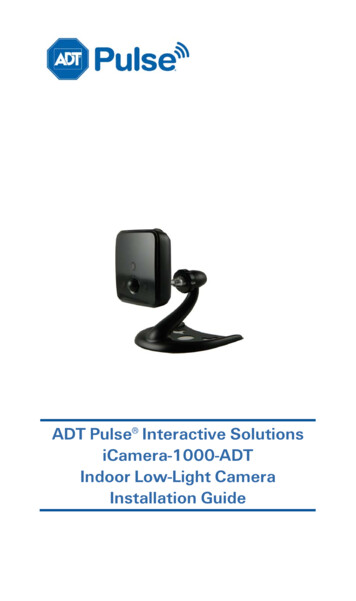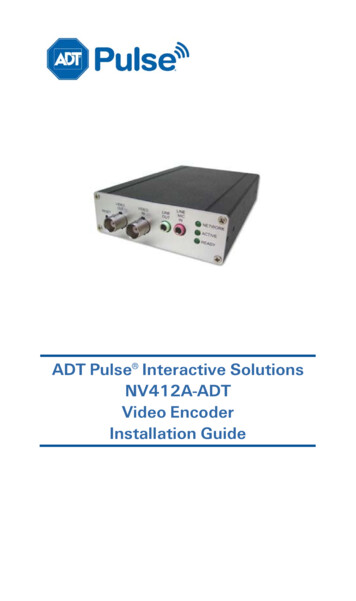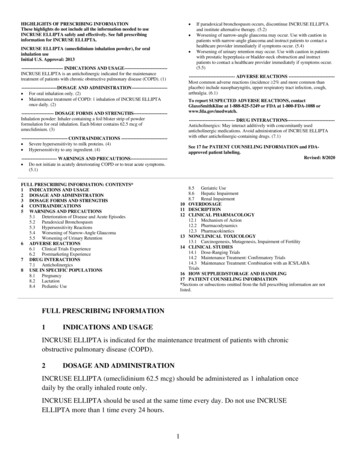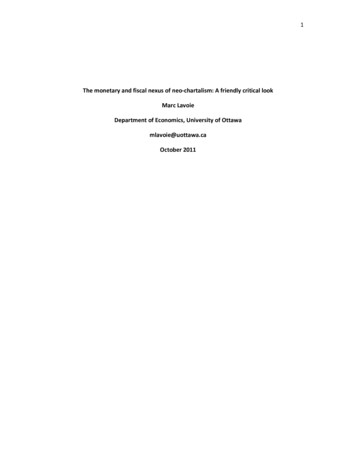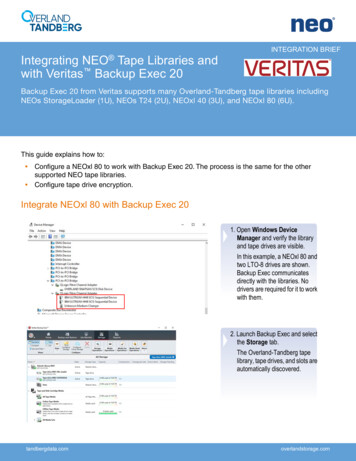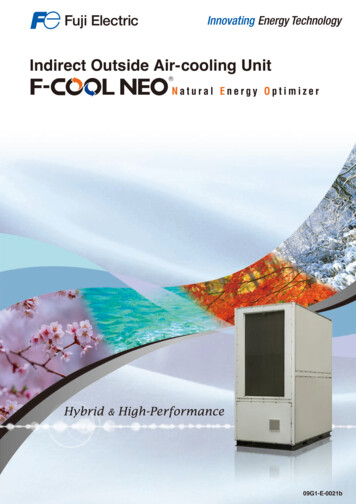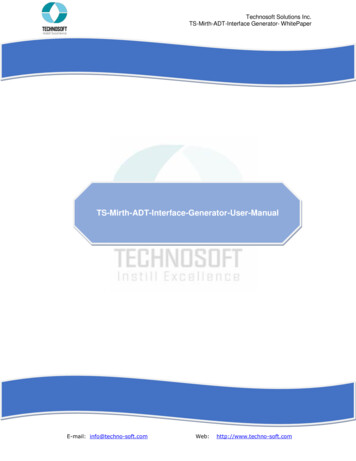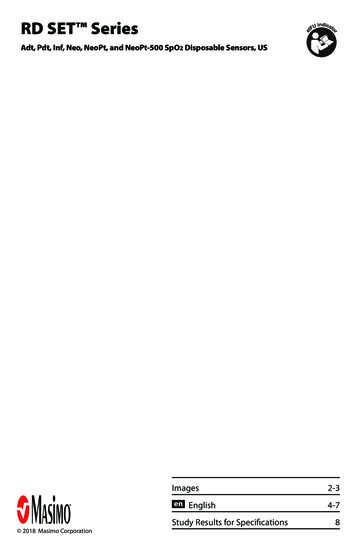
Transcription
RD SET SeriesAdt, Pdt, Inf, Neo, NeoPt, and NeoPt-500 SpO2 Disposable Sensors, US 2018 Masimo CorporationImages2-3en English4-7Study Results for Specifications8
RD SET SeriesAdt, Pdt, Inf, Neo, NeoPt, and NeoPt-500 SpO2 Disposable Sensors, USFig. 1bFig. 1aFig. 1cFig. 1dFig. 2aFig. 2bFig. 2c210131A-eIFU-1118
Fig. 3aFig. 3bFig. 3cFig. 3dFig. 4bFig. 4aFig. 4cFig. 5aFig. 5bFig. 6310131A-eIFU-1118
RD SET SeriesenAdt, Pdt, Inf, Neo, NeoPt, and NeoPt-500 SpO2 Disposable Sensors, USDIRECTIONS FOR USE 70 C-40 C 1060 hPa - 500 hPa795 mmHg - 375 mmHgLATEXSingle patient use onlyNot made with natural rubber latex Non-sterileNONSTERILE5%-95% RHPrior to using this sensor, the user should read and understand the Operator’s Manual for the device and this Directions for Use.LATEXINDICATIONS - When Used With Masimo SET and Masimo compatible Pulse Oximeters:The RD SET Series disposable sensors are indicated for the continuous noninvasive monitoring of functional oxygen saturationof arterial%hemoglobin (SpO2) and pulse rate (measured by an SpO2 sensor) for use with adult, pediatric, infant, and neonatal patients during both no motionand motion conditions, and for patients who are well or poorly perfused in hospitals, hospital-type facilities, mobile, and home he RD SET sensors are contraindicated for patients who exhibit allergic reactions to foam rubber products and/or adhesive tape.DESCRIPTIONThe RD SET Series sensors are for use with devices containing Masimo SET oximetry or licensed to use RD SET Series sensors. Consult individualdevice manufacturer for compatibility of particular device and sensor models. Each device manufacturer is responsible for determining whetherits devices are compatible with each sensor model.WARNING: Masimo sensors and cables are designed for use with devices containing Masimo SET oximetry or licensed to use Masimo sensors.WARNINGS All sensors and cables are designed for use with specific monitors. Verify the compatibility of the monitor, cable and sensor before use,otherwise degraded performance and/or patient injury can result. The sensor should be free of visible defects, discoloration and damage. If the sensor is discolored or damaged, discontinue use. Never usea damaged sensor or one with exposed electrical circuitry. The site must be checked frequently or per clinical protocol to ensure adequate adhesion, circulation, skin integrity and correct opticalalignment. Exercise caution with poorly perfused patients; skin erosion and pressure necrosis can be caused when the sensor is not frequently moved.Assess site as frequently as every (1) hour with poorly perfused patients and move the sensor if there are signs of tissue ischemia. Circulation distal to the sensor site should be checked routinely. During low perfusion, the sensor site needs to be assessed frequently for signs of tissue ischemia, which can lead to pressure necrosis. With very low perfusion at the monitored site, the reading may read lower than core arterial oxygen saturation. Do not use tape to secure the sensor to the site; this can restrict blood flow and cause inaccurate readings. Use of additional tape can causeskin damage, and/or pressure necrosis or damage the sensor. Sensors applied too tightly or that become tight due to edema will cause inaccurate readings and can cause pressure necrosis. Misapplied sensors or sensors that become partially dislodged may cause incorrect measurements. Misapplications due to wrong sensor types can cause inaccurate or no readings. Venous congestion may cause under reading of actual arterial oxygen saturation. Therefore, assure proper venous outflow from monitoredsite. Sensor should not be below heart level (e.g. sensor on hand of a patient in a bed with arm dangling to the floor). Venous pulsations may cause erroneous low SpO2 readings (e.g. tricuspid value regurgitation). The pulsations from intra-aortic balloon support can affect the pulse rate displayed on the oximeter. Verify patient’s pulse rate against theECG heart rate. Carefully route cable and patient cable to reduce the possibility of patient entanglement or strangulation. Avoid placing the sensor on any extremity with an arterial catheter or blood pressure cuff. If using pulse oximetry during full body irradiation, keep the sensor out of the radiation field. If sensor is exposed to the radiation, thereading might be inaccurate or not provided for the duration of the active radiation period. Do not use the sensor during MRI scanning or in a MRI environment. High ambient light sources such as surgical lights (especially those with a xenon light source), bilirubin lamps, fluorescent lights, infraredheating lamps, and direct sunlight can interfere with the performance of the sensor. To prevent interference from ambient light, ensure that the sensor is properly applied, and cover the sensor site with opaque material, ifrequired. Failure to take this precaution in high ambient light conditions may result in inaccurate measurements. High levels of COHb or MetHb may occur with a seemingly normal SpO2. When elevated levels of COHb or MetHb are suspected, laboratoryanalysis (CO-Oximetry) of a blood sample should be performed. Elevated levels of Carboxyhemoglobin (COHb) may lead to inaccurate SpO2 measurements. Elevated levels of Methemoglobin (MetHb) will lead to inaccurate SpO2 measurements. Elevated Total Bilirubin levels may lead to inaccurate SpO2 measurements. Abnormal fingers, Intravascular dyes such as indocyanine green or methylene blue or externally applied coloring and texture such as nailpolish, acrylic nails, glitter, etc. may lead to inaccurate SpO2 measurements. Inaccurate SpO2 readings may be caused by severe anemia, low arterial perfusion or motion artifact. To prevent damage, do not soak or immerse the sensor in any liquid solution. Do not modify or alter the sensor in any way. Alteration or modification may affect performace and/or accuracy. Do not attempt to reuse on multiple patients, reprocess, recondition or recycle Masimo sensors or patient cables as these processes maydamage the electrical components, potentially leading to patient harm. High oxygen concentrations may predispose a premature infant to retinopathy. Therefore, the upper alarm limit for the oxygen saturationmust be carefully selected in accordance with accepted clinical standards. Caution: Replace the sensor when a replace sensor message is displayed, or when a low SIQ message is consistently displayed aftercompleting the low SIQ troubleshooting steps identified in the monitoring device operator’s manual. Note: The sensor is provided with X-Cal technology to minimize the risk of inaccurate readings and unanticipated loss of patientmonitoring. The sensor will provide up to 168 hours of patient monitoring time or up to 336 hours for sensors with a replaceable tape. Aftersingle-patient use, discard sensor.410131A-eIFU-1118
INSTRUCTIONSA) Site Selection Always choose a site that is well perfused and will completely cover the sensor’s detector window. Site should be cleaned of debris and dry prior to sensor placement.RD SET Adt: Adult Sensor 30 kg The preferred site is the middle or ring finger of non-dominant hand.RD SET Pdt: Pediatric Sensor10–50 kg The preferred site is middle or ring finger of non-dominant hand.RD SET Inf: Infant Sensor3–10 kg The preferred site is the great toe. Alternatively, the toe next to the great toe, or the thumb can be used.10–20 kg The preferred site is the middle or ring finger of the non-dominant hand.RD SET Neo: Neonatal/Adult Sensor 3 kg The preferred site is the foot. Alternatively, across the palm and back of the hand can be used. 40 kg The preferred site is the middle or ring finger of non-dominant hand.RD SET NeoPt/NeoPt-500: Preterm Sensors 1 kg The preferred site is the foot. Alternatively, across the palm and back of the hand can be used.B) Attaching the sensor to the patient1. Open the pouch and remove the sensor. Remove the backing from the sensor, if present.Adt sensor for ADULTS ( 30 kg) and Pdt sensor for PEDIATRICS (10–50 kg)2. Refer to Fig. 1a. Orient the sensor so that the detector can be placed first. Place the tip of the finger on the dashed line with the fleshy part ofthe finger covering the finger outline and detector window.3. Refer to Fig. 1b. Press the adhesive wings, one at a time, onto the finger. Complete coverage of the detector window is needed to ensureaccurate data.4. Refer to Fig. 1c. Fold the sensor over the finger with the emitter window (time, around the finger.) positioned over the fingernail. Secure the wings down, one at a5. Refer to Fig. 1d. When properly applied, the emitter and detector should be vertically aligned (the black lines should align). Reposition ifnecessary.Inf sensor for INFANTS (3–10 kg)2. Refer to Fig. 2a. Direct the sensor cable so that it runs along the top of the foot. Position the detector on the fleshy pad of the great toe.Alternatively, the toe next to the great toe, or the thumb can be used (not shown).3. Refer to Fig. 2b. Wrap the adhesive wrap around the toe so the emiter is positioned on the nailbed of the great toe. Complete coverage ofthe detector window is needed to ensure accurate data.4. Refer to Fig. 2c. Ensure that the emitter window (reposition if necessary.) aligns on the top of the toe directly opposite the detector. Verify correct positioning andNeo sensor for NEONATES ( 3 kg) and NeoPt/NeoPt-500 sensor for PRETERMS ( 1 kg)2. Refer to Fig. 3a. For fragile skin, the stickiness of the medical grade adhesive can be diminished or eliminated by daubing the adhesive areaswith a cotton ball or gauze.3. Refer to Fig. 3b. Direct the sensor cable toward the ankle (or wrist). Apply the sensor around the lateral aspect of the foot (or hand), alignedwith the fourth toe (or finger). Complete coverage of the detector window is needed to ensure accurate data.4. Refer to Fig. 3c. Wrap the adhesive/foam wrap around the lateral aspect of the foot (or hand) and ensure that the emitter window ( ) alignsdirectly opposite of the detector. Be careful to maintain proper alignment of the detector and emitter windows while attaching adhesive/foamwrap to secure the sensor.5. Refer to Fig. 3d. Verify correct positioning and reposition if necessary.Neo sensor for ADULTS ( 40 kg) Inf Sensor for INFANTS (10–20 kg)2. Refer to Fig. 4a. Direct the sensor cable so that it runs along the top of the hand. Position the detector on the fleshy part of the finger.Alternatively, the sensor may also be applied to the toe (not shown).3. Refer to Fig. 4b. Wrap the adhesive wrap around the finger so the emitter window ( ) aligns on the top of the finger directly opposite thedetector. Complete coverage of the detector window is needed to ensure accurate data.4. Refer to Fig. 4c. Check the sensor to verify correct positioning and reposition if necessary.C) Attaching the Sensor to the Patient Cable1. Refer to Fig. 5a. Orient the sensor’s connector tab so that the side with the “shiny” contacts is facing up. Orient the patient cable with the colorbar and finger grips facing up.2. Refer to Fig. 5b. Insert the sensor tab into the patient cable until there is a tactile or audible click of connection. Gently tug on the connectorsto ensure a positive contact. Tape may be used to secure the cable to the patient for ease of movement.D) Reattachment The sensor may be reapplied to the same patient if the emitter and detector windows are clear and the adhesive still adheres to the skin. If the adhesive no longer adheres to the skin, use a new sensor.NOTE: When changing application sites, or reattaching sensor, first disconnect the sensor from the patient cable.E) Disconnecting the Sensor from the Patient Cable1. Refer to Fig. 6. Pull firmly on the sensor connector to remove it from the patient cable.NOTE: To avoid damage, pull on the sensor connector, not the cable.510131A-eIFU-1118
SPECIFICATIONSWhen used with Masimo SET pulse oximetry monitors, or with licensed Masimo SET pulse oximetry modules the RD SET Sensors have thefollowing specifications:RD Sensor used withMasimo DeviceRD SET Pdt 30 kg10–50 kg3–10 kg10–20 kg 3 kg 40 kg 1 kgFinger or ToeFinger or ToeThumb or GreatToeFinger or ToeHand or FootFinger or ToeHand or 3%2%2%2%2%3%2%3%3 bpm3 bpm3 bpm3 bpm3 bpm3 bpm3 bpmPulse Rate Accuracy, Motion5 bpm5 bpm5 bpm5 bpm5 bpm5 bpm5 bpmPulse Rate Accuracy,Low Perfusion33 bpm3 bpm3 bpm3 bpm3 bpm3 bpm3 bpmBody WeightApplication SiteSpO2 Accuracy,No Motion (70–100%1, 5)SpO2 Accuracy, Motion2, 5SpO2 Accuracy,Low Perfusion3Pulse Rate Accuracy,No Motion (25–240 bpm1)4RD SET InfRD SET NeoPt/NeoPt-500RD SET AdtRD SET NeoSpO2 Upper and Lower Limits of Agreement (LoA)*No MotionMotionUpper 95% LoA2.3%2.9%Lower 95% LoA-2.3%-2.2%NOTE: Arms accuracy is a statistical calculation of the difference between device measurements and reference measurements. Approximately twothirds of the device measurements fell within /- Arms of the reference measurements in a controlled study.1Specification represents clinical study results using Masimo SET Technology under no motion conditions in human blood studies on healthy adult male and femalevolunteers with light to dark pigmented skin in induced hypoxia studies in the range of 70%–100% SpO2 against a laboratory co-oximeter.2The Masimo SET Technology has been validated for motion accuracy in human blood studies on healthy adult male and female volunteers with light to darkpigmented skin in induced hypoxia studies while performing rubbing and tapping motions, at 2 to 4 Hz at an amplitude of 1 to 2 cm and a non-repetitive motionbetween 1 to 5 Hz at an amplitude of 2 to 3 cm in induced hypoxia studies in the range of 70%–100% SpO2 against a laboratory co-oximeter.3The Masimo SET Technology has been validated for low perfusion accuracy in bench top testing against a Biotek Index 2 simulator and Masimo’s simulator with signalstrengths of greater than 0.02% and transmission of greater than 5% for saturations ranging from 70% to 100%.4The Masimo SET Technology has been validated for pulse rate accuracy for the range of 25–240 bpm in bench top testing against a Biotek Index 2 simulator andMasimo’s simulator with signal strengths of greater than 0.02% and transmission of greater than 5% for saturations ranging from 70% to 100%. Pulse rate accuracyunder motion was verified by bench top testing in the range of 45-180 bpm against a Biotek simulator using the motion preset setting.5Specification reflects use with the following Masimo technology boards and software versions and higher: MS-2000 SB version V5.1, MSX-1 version V5.3, MX-5 versionV7.12*See Bland and Altman. Agreement between methods of measurement with multiple observations per individual Journal of BiopharmaceuticalStatistics (2007) vol. 17 pp. 571-582.COMPATIBILITYThis sensor is intended for use only with devices containing Masimo SET oximetry or pulse oximetry monitors licensed to use RD SETsensors. Each sensor is designed to operate correctly only on the pulse oximetry systems from the original device manufacturer. Use of thissensor with other devices may result in no or improper performance.For Compatibility Information Reference: www.Masimo.comWARRANTYMasimo warrants to the initial buyer only that these products, when used in accordance with the directions provided with the Products by Masimo,will be free of defects in materials and workmanship for a period of six (6) months. Single use products are warranted for single patient use only.THE FOREGOING IS THE SOLE AND EXCLUSIVE WARRANTY APPLICABLE TO THE PRODUCTS SOLD BY MASIMO TO BUYER. MASIMO EXPRESSLYDISCLAIMS ALL OTHER ORAL, EXPRESS OR IMPLIED WARRANTIES, INCLUDING WITHOUT LIMITATION ANY WARRANTIES OF MERCHANTABILITYOR FITNESS FOR PARTICULAR PURPOSE. MASIMO’S SOLE OBLIGATION AND BUYER’S EXCLUSIVE REMEDY FOR BREACH OF ANY WARRANTYSHALL BE, AT MASIMO’S OPTION, TO REPAIR OR REPLACE THE PRODUCT.WARRANTY EXCLUSIONSThis warranty does not extend to any product that has been used in violation of the operating instructions supplied with the product, or has beensubject to misuse, neglect, accident or externally created damage. This warranty does not extend to any product that has been connected to anyunintended device or system, has been modified, or has been disassembled or reassembled. This warranty does not extend to sensors or patientcables that have been reprocessed, reconditioned or recycled.IN NO EVENT SHALL MASIMO BE LIABLE TO BUYER OR ANY OTHER PERSON FOR ANY INCIDENTAL, INDIRECT, SPECIAL OR CONSEQUENTIALDAMAGES (INCLUDING WITHOUT LIMITATION LOST PROFITS), EVEN IF ADVISED OF THE POSSIBILITY THEREOF. IN NO EVENT SHALL MASIMO’SLIABILITY ARISING FROM ANY PRODUCTS SOLD TO BUYER (UNDER A CONTRACT, WARRANTY, TORT OR OTHER CLAIM) EXCEED THE AMOUNTPAID BY BUYER FOR THE LOT OF PRODUCT(S) INVOLVED IN SUCH CLAIM. IN NO EVENT SHALL MASIMO BE LIABLE FOR ANY DAMAGESASSOCIATED WITH A PRODUCT THAT HAS BEEN REPROCESSED, RECONDITIONED OR RECYCLED. THE LIMITATIONS IN THIS SECTION SHALLNOT BE DEEMED TO PRECLUDE ANY LIABILITY THAT, UNDER APPLICABLE PRODUCTS LIABILITY LAW, CANNOT LEGALLY BE PRECLUDED BYCONTRACT.NO IMPLIED LICENSETHIS SINGLE-PATIENT SENSOR IS LICENSED TO YOU UNDER THE PATENTS OWNED BY MASIMO FOR SINGLE-PATIENT USE ONLY. BY ACCEPTANCE ORUSE OF THIS PRODUCT, YOU ACKNOWLEDGE AND AGREE THAT NO LICENSE IS GRANTED FOR USE OF THIS PRODUCT WITH MORE THAN A SINGLEPATIENT. AFTER SINGLE-PATIENT USE, DISCARD SENSOR. PURCHASE OR POSSESSION OF THIS SENSOR CONFERS NO EXPRESS OR IMPLIED LICENSETO USE THE SENSOR WITH ANY DEVICE WHICH IS NOT SEPARATELY AUTHORIZED TO USE RD SENSORS.CAUTION: FEDERAL LAW (U.S.A.) RESTRICTS THIS DEVICE TO SALE BY OR ON THE ORDER OF A PHYSICIAN.For professional use. See instructions for use for full prescribing information, including indications, contraindications, warnings, precautions and610131A-eIFU-1118
simoadverse events.The following symbols may appear on the product or product INITIONFollow instructions for useSeparate collection for electrical andelectronic equipment (WEEE).Caution: Federal law (USA) restricts this deviceto sale by or on the order of a physicianConsult instructions for useLot codeMark of conformity toEuropean Medical DeviceDirective 93/42/EECManufacturerCatalogue number (model number)Authorized representative in the EuropeancommunityDate of manufacture YYYY-MM-DDMasimo reference numberBody weightUse by YYYY-MM-DDLight Emitting Diode (LED)LED emits light when current flowsthroughStorage temperature rangeDo not re-use/Single patient use onlyGreater thanKeep dryNon-SterileLess thanDo not use if package is damagedNot made with natural rubber latexStorage humidity limitationAtmospheric pressure limitation(blue background)GR-10199BLATEXXInstructions/Directions for Use/Manuals are available in electronic format @ http://www.Masimo.com/TechDocsNote: eIFU is not available in all countries.PCX-2108A02/13Patents: http://www.masimo.com/patents.htmMasimo, SET, X-Cal, and are federally registered trademarks of Masimo Corporation.RD SET is a trademark of Masimo Corporation.710131A-eIFU-1118
STUDY RESULTS FOR SPECIFICATIONSThe table below shows ARMS (Accuracy Root Mean Square) values measured using the RD SET sensors under no motion, with Masimo MX Technology(V7.D.2.3) in a clinical study.RD SETSpO2Arms90–100%80–90%0.83 %1.11 %70–80%1.53 %70–100%1.15 %SpO2 Upper and Lower Limits of Agreement (LoA)*Actual ValueUpper 95% LoA2.27%Lower 95% LoA-2.29%See Bland and Altman. Agreement between methods of measurement with multiple observations per individual Journal of BiopharmaceuticalStatistics (2007) vol. 17 pp. 582-571.*70 -100%(SpO2-SaO2) vs. (SpO2 SaO2)/2 Bland Altman fit and upper 95% and lower 95% limits of agreement.RD SETBy Subject810131A-eIFU-11
Adt, Pdt, Inf, Neo, NeoPt, and NeoPt-500 SpO2 Disposable Sensors, US DIRECTIONS FOR USE . Verify the compatibility of the monitor, cable and sensor before use, . (e.g. sensor on hand of a patient in a bed with arm dangling to the floor). Ve
